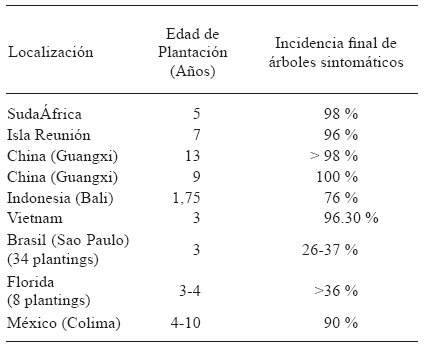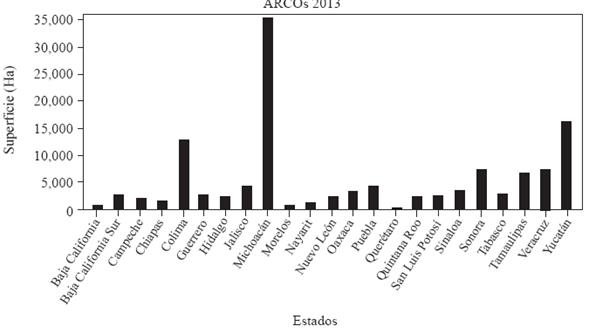Services on Demand
Journal
Article
Indicators
-
 Cited by SciELO
Cited by SciELO -
 Access statistics
Access statistics
Related links
-
 Similars in
SciELO
Similars in
SciELO
Share
Revista mexicana de fitopatología
On-line version ISSN 2007-8080Print version ISSN 0185-3309
Rev. mex. fitopatol vol.32 n.2 Texcoco 2014
Review articles
Current situation and Prospects for Management of Citrus HLB
1 Colegio de Postgraduados, Campus Montecillo-Fitopatología, Texcoco, Edo. de México.
2 Dirección de Protección Fitosanitaria-DGSV. México, D. F.
3 INIFAP-CE General Terán. General Terán, Nuevo León.
4 Centro Nacional de Referencia Epidemiológica Fitosanitaria (CNRF)- DGSV México, D.F.
Huanglongbing (HLB), a disease induced by the bacteria Candidatus Liberibacter spp. and transmitted in the Americas by the Asian Citrus Psyllid (ACP) Diaphorina citri Kuwayama, is currently known as the most devastating citrus disease worldwide (Bové, 2012).
On a global scale, a high epidemic impact of HLB is reported to have incidence levels of 26 % (Brazil) to 100 % (China) (Table 1). In addition, losses reported worldwide with quantitative and epidemiological foundations vary regarding the species evaluated, i.e., losses reported for sweet orange are of 42 %, along with 62 % for Mexican lime, and 17.3 % for Persian lime (Table 2).
In Mexico, the epidemic scenarios of HLB have been categorized in two regions due to the occurrence and intensity of the disease: Pacific region (High intensity) and Yucatan Peninsula region (Low intensity) (Figure 1).
The above suggests that HLB management with an epidemiological basis must consider the variation of epidemic intensity (Figure 1), due to the vulnerability of prevalent citrus species, citrus compacting, and mainly, load of inoculant in the region. The load of inoculant has an implication in the temporary (speed) and spatial (distance of propagation) behavior of the epidemic (Figure 2) and determines the thresholds under which the primary inoculant should be operated, through the eradication, and the secondary inoculant, through the control of the vector.
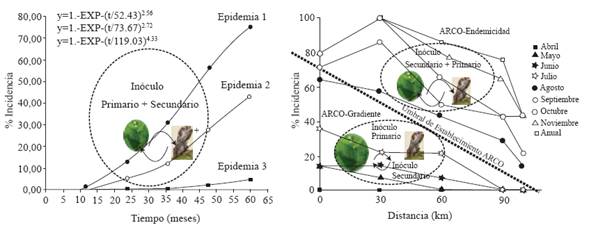
Figure 2 Epidemiological basis of HLB management with emphasis on the type of inoculant: A) Temporary focus and B) Spatial focus.
HLB management takes place via three strategies: eradication, control of the vector, and use of certified plant material. The last one is the most complicated to perform due to the social problem it implies, since it requires voluntary and normative means. To this end, the OIRSA developed, for its member countries, the regional normative harmonization guidelines for the phytosanitary certification of citrus propagation material, a normative document which establishes the phytosanitary procedures and requirements for the regulation of citrus propagation material (OIRSA, 2012).
Regarding eradication, Brazil is an example of success in the application of this strategy, in combination with the chemical control of the vector (Bassanezi, 2010).
Vector control is mainly carried out using chemical products and, to a lesser extent, with biological control, using parasitoids, predators, and entomopathogens (Pacheco et al, 2012).
In Mexico, ACP is controlled by releasing Tamarixia radiata. To date there are 2 massive reproduction laboratories that allow coordinated releases in the different citrus-producing regions of the country (Arredondo-Bernal, 2013) (Figure 3).
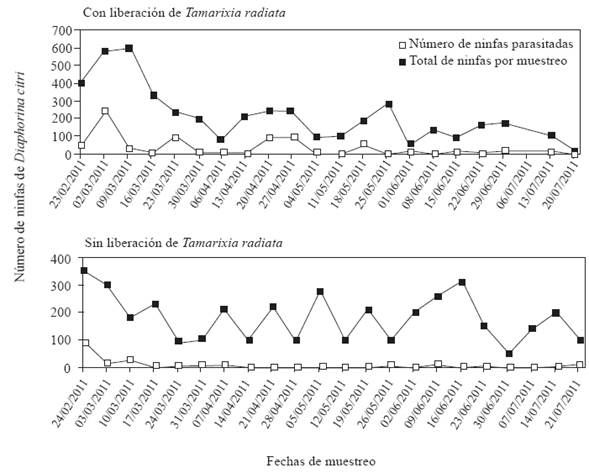
Figure 3 Effect of the releases ofz T. radiata on the number of D. Citri nymphs, in Colima. Source: Arredondo-Bernal, 2013.
Regarding chemical control, in Mexico, products approved by SENASICA were validated by INIFAP by means of an evaluation of conventional and alternative insecticides recommended for the control of ACP for their effectiveness and resistance induction (IRAC, 2012), and from which a program was produced for the sustainable management of resistance to insecticides, for its nationwide recommendation and use (Table 3 and Figure 4) (Cortéz et al, 2013).
Table 3 Insecticides authorized for use in citrus against ACP in Mexico (SENASICA, 2012).
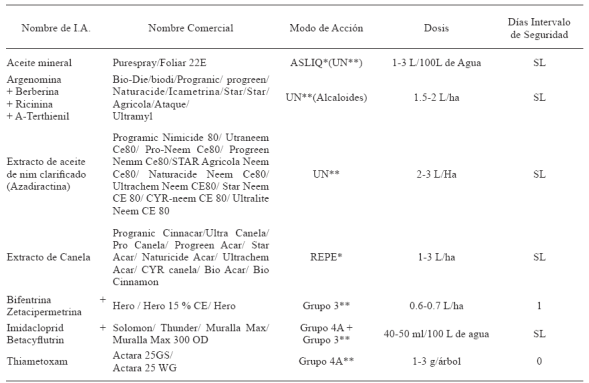
Insecticides authorized by SENASICA, until September 2012. A.I. = active ingredient. *According to Rodríguez and Silva (2003). **According to IRAC (2012). NL= no limit.
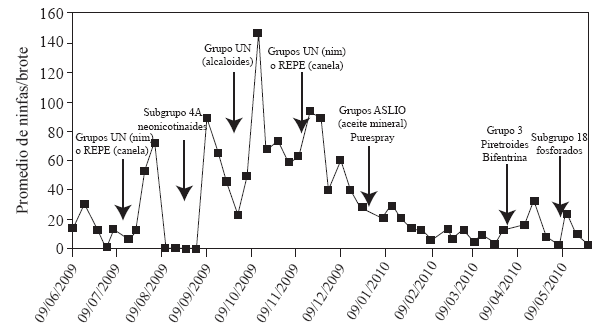
Figure 4 Proposal of insecticide rotation to manage the resistance of ACP. Based on budding, population dynamics, and biology of ACP and environmental conditions.
However, the strategy that displays the highest efficiency for the control of HLB is region-focused. Bové (2012) points out that the farmers located in areas with low HLB incidence must form compact areas of regional management, of at least 500 ha, in which vectors are controlled and diseased plants are eliminated.
The technical reasons for implementing and maintaining broad APC control areas, particularly with the presence of HLB in a region, are the following: 1) delay the beginning of the epidemic by approximately 299 days, 2) effectively reducing the infection by reducing the population of psyllids from adjacent orchards has a great effect in the reduction of incidence (90 %) and rate of progress (75 %) of HLB; incidence begins later and is slower, 3) reduce the population of local psyllids (by 76 to 97 %), even in abandoned orchards, 5) it allows the use of a less intensive local vector control program, and 6) it reduces HLM management costs, since applications are less intensive and more efficient (Bassanezi, 2010).
Due to the above, in 2011, the National Food and Agriculture Health, Safety, and Quality Service (SENASICA) of the General Plant Health Office (DGSV) implemented a pilot D. citri control program in the states of Colima, Michoacan, and Yucatan, in which oils, potassium salts, and chemical products were applied on an estimated surface of (Robles, 2012). In addition, Robles (2012) mentions that the DGSV, SENASICA, in collaboration with the National Institute of Forestry, Agriculture and Livestock (INIFAP), scientists from other institutions and technicians from the Auxiliary Plant Health Organisms produced the Protocol to establish regional areas for the control of Huanglongbing and the Asian Citrus Psyllid (ARCOs).
Bové (2012) points out that in the case of small producers that are located in areas with low incidence of HLB, must form compact areas of regional management of at least 500 hectares where they perform the control of the vector and the elimination of diseased plants. While this assertion has not epidemiological support, it points out a central problem relative to the area that must include an ARCO. A rational strategy to respond in Mexico about this technical requirements was the application of dispersion rates obtained by the research of spatial gradients for HLB and other pathogens transmitted by vectors (Flores-Sánchez et al., 2011; Mora-Aguilera y Escamilla-Bencomo, 2002) combined with risk and endemicity factors (Figure 2B, Figure 5).
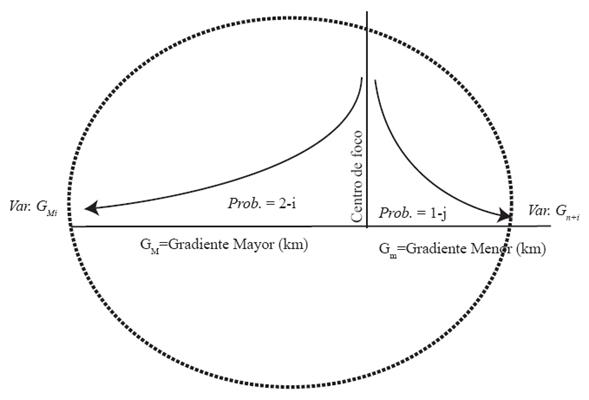
Figure 5 General epidemiological model for estimating a regional management area (ARCO) based on the concept of asymmetric dispersion of CLas through its vector D. citri.
With this support the ARCOs were conceived based on gradients-risk for low or null prevalence conditions of the disease (p.e. Veracruz, Tamaulipas and Nuevo Leon) and ARCOs based on prevention and protection (Mora-Aguilera et al., 2013).
The calculation of an ARCO involves estimation of the number, location and control area. This aspects represent the weighted by risk factors applied to state level and the use of Monte Carlo simulation.
The proposed equation is as follows:
Where:
Area = Size of risk area about to define by region. The basic unit is the municipality of citrus cultivation and the total area is the federal entity.
3.15 = Constant value to calculate the area.
ratedisp = Distance of dispersion of HLB per month from an initial focus on a region of recent income with active dispersion
Factpond =Product of the weighting variables selected (citrus surface, index of susceptibility and burden of inoculum).
t = Time to determine the risk area size.
The quantitative basis denote the analysis of data of HLB epidemics in Brasil (Sao Paulo) ((Bassanezi, 2010), EUA (Florida) (Irey, 2009) and Mexico (Colima and Yucatan) (Robles-González et al., 2013; Flores-Sánchez et al, 2011). Spatial data was used to determine dispersion gradients with directionality in relation to the prevailing winds to generate epidemic scenarios for the Monte Carlo simulation (Table 4) and its implementation through a web application called @RCOS. A federative entity can have more than one ARCO and the number and localization is determined based on the risk level that they are willing to manage (p.e. 80-90%), as well as the infrastructure, human and economic resources available in the entity (Mora-Aguilera et al, 2013).
The five components considered for the establishment of the ARCOs in Mexico are the following:
) Organization: Gives rise to the formation of a technical group specialized in the topic of each of the states with a campaign, designates a technician in charge of each ARCO, a leading farmer, and a facilitator that promotes the participation of the farmers.
) Characteristics of ARCOs: The implementation of the ARCOs is prioritized based on the following biological and epidemiological criteria: a) abundance of hosts, b) vulnerability of the hosts, c) amount of, and distance between, sources, d) load of inoculant, and e) direction of the predominant wind.
) Monitoring the vector: Uses yellow traps to measure the population of the ACP in a region and by host species, evaluate the impact of the total regional applications of chemical and biological control, determine periods of total regional application, avoid unnecessary applications and identify appearances of the insect by orchard (sources of infestation). To facilitate the capture, shipping, and processing of the data obtained every week from the traps, SIMDIA (Diaphorina Monitoring System) is used, through which information is obtained at a national scale, as well as from each state, ARCO, orchard, and trap, which facilitates decision-making at these different levels.
) Adequate use of insecticides. Both in regional applications and in the attention to sources of infestation found by monitoring, insecticides are used that are registered before COFEPRIS for their use against ACP, specifically. Products can also be used that are registered for use with other pests in citrus plants and those that require no registration (soaps and detergents), but have been evaluated by INIFAP for use against this vector. The Protocol places particular emphasis on the rotation of the different toxicological groups for the management of the insect's resistance.
) Use of biological control. A crucial component for the control of ACP in urban areas, adjacent or within the ARCOs, as well as abandoned orchards that are part of the ARCOs, is the production and release of Tamarixia radiata, an ACP-specific parasitoid. Likewise, in the ARCOs' commercial orchards with the relative temperatures and humidity, total regional applications of entomopathogenic fungi are carried out; both the strain and the dose used in each ARCO stems from investigation carried out by the National Biological Control Reference Center.
This strategy implemented in the 23 states with campaigns (Baja California, Baja California Sur, Campeche, Colima, Chiapas, Guerrero, Hidalgo, Jalisco, Michoacan, Morelos, Nayarit, Nuevo Leon, Oaxaca, Puebla, Queretaro, Quintana Roo, San Luis Potosí, Sinaloa, Sonora, Tabasco, Tamaulipas, Veracruz, and Yucatan) in 2013, 120,000 ha. are being tended to, so as to impact the insect populations, contribute to the mitigation of the disease spreading, and promote the participation of the farmers in the ARCOs, as a crucial element to confront HLB (Figure 6).
However, the five components suggested above omit the epidemiological characteristic to determine the number, location, and size of the ARCOS, therefore it was necessary to develop a proposal to incorporate these elements and justify its implementation. To develop this proposal, the control of the inoculant was considered with spatial criteria, with an emphasis on the potential for the spreading of HLB, inoculant pressure, host surface, and vulnerability of citrus species. The potential for the spreading of HLB in a region is based mainly on the wind, host availability, and its level of compacting and size of the source. To this end, data were analyzed from Brazil (Sao Paulo) (Bassanezi, 2010), U.S.A. (Florida) (Irey, 2009), and Mexico (Colima and Yucatan) (Robles-González et al., 2013; Flores-Sánchez et al., 2011) in which there were reports of the spatial and temporal progress of the HLB. This data was then used to determine gradients of dispersion with a directionality based on the predominant winds. In all four scenarios, a gradient was found for greater distance downwind (GM), and another gradient was found for less distance against the wind (Gm). The rate of dispersion was obtained with the monthly distance of dispersion.
LITERATURA CITADA
Arredondo B., H. 2013. Control Biológico: Componente de las Áreas Regionales de Control del PAC. In: Memorias de la Reunión Nacional de Sanidad Vegetal. México, D.F. 16-19 Abril. [ Links ]
Bassanezi, R. B., Montesino, L. H. and Stuchi, E. S. 2009. Effects of huanglongbing on fruit quality of sweet orange cultivars in Brazil. European Journal of Plant Pathology 125:565-572. [ Links ]
Bassanezi, R. 2010. Epidemiología del HLB y sus implicaciones para el manejo de la enfermedad (presentación). Taller de enfermedades de alto impacto-cuarentenadas en el cultivo de los cítricos. III Simposio Internacional de Fruticultura tropical y subtropical. La Habana, Cuba. 26 al 30 de octubre de 2010. [ Links ]
Bassanezi, R. B. , Montesino, L. H. , Godoy G., M. C., Filho, A. B. and Amorin, L. 2011. Yield loss caused by huanglongbing in different sweet orange cultivars in Sao Paulo, Brazil. European Journal of Plant Pathology 130:577-586. [ Links ]
Bové J.M. 2012. Huanglongbing and the future of citrus in Sao Paulo, State, Brazil. Journal of Plant Pathology (2012), 94 (3), 465-467. Edizione ETS Pisa, 2012. [ Links ]
Cortéz, M. E., Loera, G. J., Hernández, F. L., Barrera, G. J., Fontes, P. A., Díaz, Z. U., Jasso, A. J., Reyes, R. M., Manzanilla, R. M. y López, A. J. 2013. Manual para el Uso de Insecticidas Convencionales y Alternativos en el Manejo de Diaphorina citri Kuwayama en Cítricos, en México. Folleto Técnico No. 36. INIFAP. [ Links ]
Flores-Sánchez, J. L., Mora-Aguilera, G., Loeza-Kuk, E., Domínguez-Monge, S., Acevedo-Sánchez, G. y López-Arroyo, J. I. 2012. Yield Loss Modeling of Candidatus Liberibacter asiaticus on Persian Lime (Citrus Latifolia) in southern Mexico. Book of Abstracts of the XII International Citrus Congress. S12P01 199p. Valencia, Spain. 18-23 November. [ Links ]
Flores-Sánchez, J. L., Mora-Aguilera, G., Loeza-Kuk, E., Domínguez-Monge, S., Acevedo-Sánchez, G., Rivas-Valencia, P., Ruiz-García, N., López-Arrollo, J. I., Hernández-Chan, E., Novelo-Cocon, A., López-Sánchez, P., y Sánchez-Rebolledo, F. 2011. Gradientes de Dispersión del HLB a partir de Focos Iniciales de Infección en la Península de Yucatán. Memoria del 2do. Simposio Nacional sobre Investigación para el Manejo del Psílido Asiático de los Cítricos y el Huanglongbing en México. 5 y 6 de Diciembre. Colegio de Postgraduados. Montecillo, Texcoco, Edo. de México. pp: 83-87. [ Links ]
Gottwald. T. R. 2010. Current Epidemiological Understanding of Citrus Huanglongbing. Annual Review of Phytophalogy. 48:119-139. [ Links ]
IRAC (Insecticide Resistance Action Committee). 2012. IRAC MoA Classification Scheme. IRAC International MoA Working Group. IRAC ejecutive. Version 7.2 (Issued, April 2012). 23 p. [ Links ]
Irey, M. 2009. Currente Status of Managenment in Florida. Taller Internacional de Plagas Cuarentenarias de los Cítricos. Villahermosa, Tabasco. [ Links ]
OIRSA (Organismo Internacional. 2013. Norma Regional de Sanidad Vegetal (NRSV): Lineamientos de Armonización Normativa Regional de Certificación Fitosanitaria de Material Propagativo de Cítricos. [ Links ]
Pacheco, C. J., Samaniego, R. J. y Fontes, P. A. 2012. Tecnología para el manejo integrado del psílido Diaphorina citri Kuwayama (Hemíptera: Psyllidae) en cítricos en Sonora. Folleto Técnico No. 88. INIFAP. [ Links ]
Robles G, M. M., Velázquez, M. J. J., Manzanilla, R. M. A., Orozco, S. M., Medina, U. V. M., López-Arroyo, J. I. y Flores-Virgen, R. 2013. Síntomas del Huanglongbing (HLB) en Limón Mexicano (Citrus aurantifolia) y su Dispersión en el Estado de Colima, México. Revista Chapingo Serie Horticultura. 19(1): 15-31. [ Links ]
Robles, G. P. 2012. Protocolo para establecer Áreas Regionales de Control del Huanglongbing y el Psílido Asiático de los Cítricos (ARCOs). http://www.senasica.gob.mx/?doc=9364. [ Links ]
Rodríguez, M. J. C., y G. Silva, A. 2003. Manejo de la resistencia a los insecticidas. In: silva, A. G., y R. Hepp, G. (eds.) Bases para el manejo racional de insecticidas. Trama Impresores, S. A. Chillán, Chile. pp 263-289. [ Links ]
Received: December 01, 2014; Accepted: January 27, 2016











 text in
text in 

